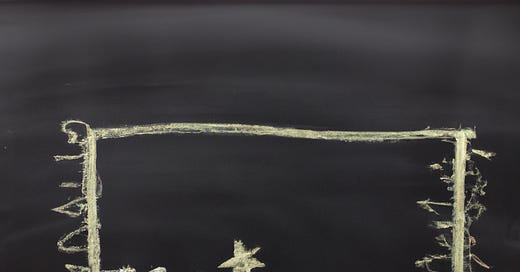The Lessons of Immigration: We Want to Hear from You
And scroll down for a children’s story about stars, family, and loss
This week we want your help.
We want to know what kinds of lessons you learned about immigration while you were a student. If you were ever a teacher, we also want to know what kinds of lessons you might have taught about immigration.
Even if your answer is “nothing” or “not enough,” we want to know! Please comment below (and you can always email us here).
We want to know about your experiences learning about immigration because we want to compare the lessons shared here with the information encountered in classrooms. Part of our goal with La Cuenta is to account for the continually amounting costs of undocumented survival in the U.S. that we share here each week. These are often invisible to most individuals in this country. Schools are complicit in overlooking the humanity of those the U.S. labels as undocumented.
Talking with one of my doctoral advisees and a former high school teacher, Rita Kamani-Renedo, we struggled to pinpoint the specific moments that young people encounter lessons about immigration in U.S. schools. As we reflected on the lessons taught in our respective high schools (in California and New York), we could point mainly to lessons of American progress and exceptionalism fueled by European immigration. Students might learn about Ellis Island and the notion that “good” immigration happened a long time ago.
But we know that students learn, every day, the ways borders cleave families and policies limit the freedoms of those around us. The hidden curriculum of immigration learning is taught long before kids enter our classrooms and lingers on the screens of nightly news and the headlines of articles and social media posts.
If not in schools, where did your formative experiences learning about immigration take place?
Propina
Back when I was a high school English teacher in South Central Los Angeles, the majority of my students came from Mexico and from Central America. Daily, my classroom was filled with the lessons learned from immigration experiences and the global forces that stretched families across the distances of time and place.
Recently, I stumbled across samples from an assignment where I asked my students to create autobiographical children’s books. The majority of my students focused on aspects of family members going to or leaving the U.S. and I want to share portions of one student’s story about a character she called “Mini-U.” This student imagined her family as a constellation of stars, their love burning brightly, even as they are scattered across the sky. Below are a few pages of this story as one way we might offer lessons of immigration to children from children:




Mini-U is a reminder of the lessons we could learn in schools if we choose to center youth voices.






I grew up in a border state (Arizona) was taught next to nothing about immigration, including in post-secondary and graduate school.
I taught a unit here in Los Angeles where students retraced the origin of xenophobia up to the present day. They also compared the experiences of America’s original immigrants (pilgrims) with those of immigrants in the present-day.